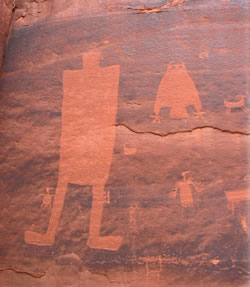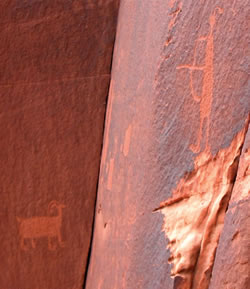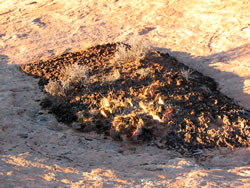Hiking
Happenings September 2005
Interactive
Rock Art
by Rory Tyler
Way
back in the twentieth century some gay blades on the
cutting edge of the avant garde carved out a niche known
as ‘interactive art’;
art that either requires participation by the viewer or
interacts directly with the environment to activate its
aesthetic merits. It all seemed quite novel at the time,
but I think the concept may have existed, in one form or
another, for as long as the concept of art itself. For
example, in his book “Mind in the Cave,” David
Lewis-Williams, presents a series of reasonably plausible
hypotheses concerning potential interactive qualities in
the paintings and caves of southern Europe.
It shouldn’t be too surprising then, if interactive characteristics
show up in the rock art of the American Southwest. The most spectacular
and (now) obvious examples come in the form of archeo-astronomical panels.
These are ancient Indian petroglyphs that use light, shadow, and landscape
to commemorate specific astronomical phenomena; particularly solstices
and equinoxes. (If you already have some knowledge and interest in the
subject, I’ll remind you that this autumnal equinox occurs on Thursday,
September 22 at 2:24 p.m. MDT.)


Two views of the Owl
Panel
|
But,
and some might say I’m treading on a thin ledge here, I think there
may be other examples of interactivity in the gallery of
Southwest rock art that don’t rely on astronomical
events to inform them. What they require is the proper
viewing perspective, and some imagination, to reveal elements
of their intended content. In this column I’ll present
this idea by discussing three panels on Kane Creek Road.
If you visit these panels and conclude that I should have
spent more time in the shade this summer… well,
at least you’ve had a nice walk.
To get to Kane Creek Road drive to the south end of town
and turn between McDonald’s and Burger King, the Scylla and Charibdas of Moab haute
cuisine. The road hugs the cliff on the left, meets the river, then comes
to a cattle guard about five miles from town where it turns to dirt.
The first rock art I’ll point you to is one of Moab’s better-known
little-known displays; the Owl Panel on the Amasa Back Trail. This trail
starts about a mile from the aforementioned cattle guard. Directly across
the canyon from the trailhead there is a large eye-shaped alcove. The
Owl Panel is about 100 feet to the left of that alcove.
This
panel is a real beauty and the Owl is the best-made of
several in the area. The little vulture glyphs are, to
my knowledge, regionally unique although they bear a
striking similarity to vulture figures at Catal Huyk,
Turkey, site of the world’s
oldest excavated temple; a resemblance I hope is coincidental.
My best guess is that the Owl Panel was made by Fremont
Indians somewhere between eight hundred and eleven hundred
years ago. The Owl Panel consists of three facets. The
first, a narrow wall offset on the left, has a single bighorn
sheep. The central panel includes a very large human figure,
the owl, the vultures, and a line of sheep.
The third, also offset from the central panel, has a single figure holding
a drawn bow and arrow
Now here’s the fun part. Go thirty feet to the right and step up
on the stone pedestal there. Take a look at the hunter now. You can see
he’s just waiting for that first sheep to come around the corner
then…Wham! And you’re right there in the hunt, anticipating
the imminent attack. So is the little sheep down by your right ankle
as he watches every move the hunter makes.
Frankly, I don’t think that hunter is going to get the first sheep
in the line. See how alert and nimble it is? Literally on its toes. My
guess is that the second sheep, the crippled runt behind it, will have
the honor of greasing the fingers of the hunter’s family tonight.
However, I do believe the artist wanted us to stand behind his hunter
and get that feeling of being part of the action, or interaction, if
you will.
Two more possible examples of interactive rock art are on the cliff
walls of the side canyon at the bottom of the hill you just came up.
I think these panels were probably pecked out by the Basketmaker Indians
whose culture prevailed here for about eight hundred years before the
Fremont took over. These interactions are not, I’ll warrant, as obvious
as the Owl Panel’s. Therefore, I suggest a visit to the Owl Panel
first to get a feel for the possibilities. To get to these panels, start
at the parking lot a half-mile from the cattle guard, cross the road,
and take the trail up to the point above you. When you reach the shelf,
you’ll see that the fractures in the rock wall have created a vertically
folded or pleated topography. This pleating is the geological feature
that the next artist used as an interactive foil.
About thirty yards down the wall from the first rock art panel is an
enigmatic shield-shaped glyph filled in with horizontal lines. Two of
the lines leave the shield, going left. When they meet the edge of the
stone pleat, they stop. Or do they? If you get next to the wall and look
down a few yards past the shield, you’ll see two lines over there
on another pleat that have a close sense of visual continuity with the
lines that leave the shield. Both of the distant lines start with a large
dot. Now go back to the shield-figure and look around the corner. See
the two dots? I’ll admit, it’s flimsy evidence, but I suspect
that there’s a strong connection between the two panels that you
probably wouldn’t get if you didn’t put yourself in the right
place and frame of mind. Unlike the Owl Panel, however, I don’t
have any notion at all about what this represents.
The last example is another fifty yards or so down the same wall. A
line of sheep, going left to right, walk toward a very distinct vertical
crack in the rock. A foot or so to the left of the crack the petroglyphs
begin again with some amorphous peck-marks, as if someone began making
a sheep’s
body but stopped. The next figure is also incomplete, though it has enough
details to indicate a resemblance to a sheep. The third figure is a full-formed
sheep, the last in another line of sheep done in the same style as the
group to the right. This stylistic continuity argues that all these figures
were done by the same artist and that the artist was trying to illustrate
a story that had something to do with that crack.
Go back to the crack. The figure closest to it isn’t a sheep. It’s
a man. To me, this looks like it could be some sort of shamanic tale
about sheep mysteriously disappearing into the earth then rematerializing
later in some new place and time. I’ll admit it’s all guesswork,
but I like the concept. However, if after due consideration you think
I’m as profoundly cracked as that rock wall, just keep going for
another mile or two and the beautiful views along this relatively easy
trail may soften any residual contempt you hold for my suspicious ditherings.
Or, if you’re reading this in a coffee shop, you can tear the page
out, fold it into a paper crane, airplane, or anthropomorph and tell
your barristas that if they present it to me on the autumnal equinox
I’ll give them each a dollar. There’s interactive for you.

Cryptobiotic soil
garden
|
Rory Tyler is available for cowboy
poetry/campfire song gatherings which include lore, science,
history and lies of the Moab area. (Suitable for all
age groups). Rates are negotiable. Give Rory a call at
435-260-8496.
|


